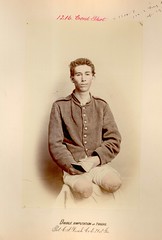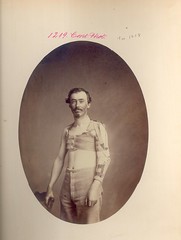- his one soldier is Frederick Bentley.
An unofficial blog about the National Museum of Health and Medicine (nee the Army Medical Museum) in Silver Spring, MD. Visit for news about the museum, new projects, musing on the history of medicine and neat pictures.
Friday, July 22, 2011
Creative use of Museum's Civil War photos at Flickr
- his one soldier is Frederick Bentley.
Tuesday, May 24, 2011
Confederate photographs uploaded to Flickr
We’ve had a request for pictures of Confederate soldiers and have posted what should be every one to Flickr at http://www.flickr.com/search/?w=99129398@N00&q=confederate&m=text
Tuesday, May 10, 2011
More Civil War soldier photographs added to Flickr
Tuesday, April 19, 2011
Contributed photograph 1164
Contributed Photograph 1164
TINEKER, SAMUEL T.
EXCISION OF HEAD AND 3 INCHES OF SHAFT OF HUMERUS.
PVT, Company D 14th INDIANA VOLUNTEERS
Battle of the WILDERNESS, 6 MAY 1864
Dr JC MCKEE, LINCOLN GENERAL HOSPITAL, WASHINGTON, D.C.
See also SP 146
BOUND IN LINCOLN, VOL. 2. HISTORY ON VERSO. TINTED.
CIVIL WAR
Tuesday, March 15, 2011
Letter of the Day: March 13
De Camp General Hospital, U.S.A.,
Davids’ Island, New York Harbor,
Mar. 13th 1866
My dear Doctor,
I have sent by Adams Express Co. to the address of the Surgeon General, a box containing some photographs of surgical cases, and the histories there of rather imperfectly obtained by me from personal interviews with the patients and statements given by others. The box also contained a humerus and bullet relative to one of the cases. I likewise sent three additional photographic views of this Hospital which will complete the series taken, five of which have been previously forwarded by me to the Army Medical Museum.
Will you oblige me by forwarding a copy of Circular No 6 to the following address: Dr. S.F. Morris care of R.L. Morris, M.D., Pelham, P.O. Westchester Co., N. York.
Yours very truly
Warren Webster
Dr. Otis, +c. +c.
Wednesday, February 9, 2011
19th century medical photographs with mirrors
Until he asked about these types of photographs, my eye had glided over them.
Wednesday, December 22, 2010
Civil War images posted to Flickr
I'm posting all the Civil War pictures from the Contributed Photograph collection to Flickr, in numerical order, unless we've already put them online there in the past. However we're missing large parts of the collection for various reasons, so if there's a gap between CP 543 and CP 572, it's because we no longer have the intervening 29 photographs.
Most of these photographs have never been seen by the general public. I think the level of interest shown in the largely anonymous photographs recently donated to the Library of Congress shows that there is an interest in seeing the people that fought 150 years ago.
Some of the pictures are disturbing due to either violence or exposed genitalia, and I’ve thought twice about posting them. The Flickr site is open to anyone and photographs of genitals are not something everyone wants to see. However, the first hernia picture we have was by Dr. Reed Bontecou, one of the more famous Civil War medical photographers (or it was commissioned by him). Additionally, due to the draft and volunteerism, not everyone who fought in the Civil War was young and healthy, and problems like hernias resulted, but were less easily treated surgically than they are now. Finally, as we get a little farther along in the series of Civil War pictures, there will be many gruesome physical injuries with exposed viscera, and they should be just as troublesome to modern viewers. When I get done with these pictures, I’ll work through the 400 Surgical Photographs that the museum published between 1862 and 1881.
Friday, December 10, 2010
Civil War photos slowly be added to Flickr
I’m posting about three pictures a day to Flickr from the Contributed Photographs collection. Many of these images are from the Civil War -
http://www.flickr.com/photos/medicalmuseum/sets/72157614294677868/
Wednesday, November 24, 2010
Peek into the Archives: Contributed Photographs collection
The "Contributed Photographs" collection, as it came to be known, consists of photographs donated or contributed to the Museum. Photographs arriving during and after the war were usually added to the Surgical Section and numbered like the bones were. Many photographs were sent by doctors who wished to see their cases included in the History. Doctors such as Reed Bontecou of Harewood Hospital in Washington, J.C. McKee of Lincoln General Hospital in Washington (who also provided surplus photographic equipment after the Museum's burglary), and J.H. Armsby of Ira Harris General Hospital in Albany, New York, contributed dozens of photographs at the end of the war. They received photographs from the Museum in exchange. Most of the photographs given to the Museum were albumen prints, but infrequently a tintype (a photograph printed on thin metal) was donated. (Otis to Lyster, May 11, 1866) Tintypes were never as popular as other photographs. (Welling, p. 117) Their dark background made medical subjects harder to see and reproduce in print.
Otis frequently wrote to surgeons requesting a photograph of a specific case which he would then have engraved for the History. He also wrote to patients asking them to have their wound photographed. Otis wrote to Charles Lapham, who had been with Co. K of the 1st Vermont Cavalry:
The interesting report of your case, which is recorded
in this office, leads me to desire to possess if possible, a
photograph which shall farther illustrate it. The Surgeon
General possesses photographs of a number of the very rare
cases in which patients have survived after the very grave
mutilation of the removal of both thighs, and has instructed
me to request you to have a photograph prepared, the expense
to be defrayed by this office.
It would be well to have two pictures taken: one
representing the stumps, the other the appearance with
artificial limbs attached.
The photographer might take two or three prints of each
to be retained by you, and then should forward the
negatives, carefully packed to this office, by express,
enclosing at the same time the bill for his services.
I enclose copies of a photograph of the size desired.
(Otis to Lapham, May 25, 1865)
Lapham had the work done and two photographs were added to the collection.
Otis commissioned physicians such as E.D. Hudson of New York City to take photographs for him. Writing to Hudson, Otis said "I am anxious to obtain photographs of double amputations of the thigh or leg and of other cases of unusual interest, and am willing to pay for such. I hereby authorize you to have photographs taken of cases of especial interest. As near as may be they should be uniform in size with those taken at the Army Medical Museum, of some of which you have copies." In the same letter, Otis sent a list of soldiers who had survived the operation of the excision of their humerus. Hudson, a maker of prosthetics, undoubtedly appreciated Otis' fulfilling his request for the names. Otis and Hudson's arrangements to look out for each others interests, resulted in striking photographs such as the two of Columbus Rush, a young Confederate from Georgia who lost both legs. (Otis to Hudson, February 7, 1866) Otis and Hudson cooperated so closely that Hudson was able to display his prosthetics in the Medical Department's exhibit at the Centennial fair. (Otis to Hudson, March 8, 1876)
For many years, these photographs received a Surgical Section number and were bound in volumes labeled Photographs of Surgical Cases. (Otis to Washburne, April 4, 1866) The photographs donated to the Museum were often rephototographed to be included in the Surgical Photograph series. Roland Ward's plastic surgery after the destruction of his lower jaw (SP 167-170, 186) is an example. Columbus Rush's photograph, in which he demonstrates his Hudson-made artificial legs, was copied and sent out as part of the series. Otis also purchased photographs from studios, buying "two dozen of the war views for the Museum" from E. & H.T. Anthony & Co. (Otis to Anthony, September 25, 1865)
Contributors of photographs like Hudson also used the pictures themselves. Dr. Gurdon Buck is particularly noteworthy for his use of photographs. He had engravings made of "before and after" photographs for his 1876 text on plastic surgery, Contributions to Reparative Surgery. In the engravings, Buck used drawn lines to explain his operation. Buck deposited a set of his photographs in the Army Medical Museum soon after the end of the war.
About 1876, as photographs of many sizes and from many people continued to arrive, the collection was removed from the Surgical Section and named the Contributed Photographs. Otis no longer had the photographs bound in albums. All of the photographs were renumbered from the beginning in red ink with the identifying "Cont. Photo." or the initials "C.P."6 Some of the best photographs were copied in the Museum and published as part of the Surgical Photograph series. Others were engraved for the History. Some photographs almost certainly taken by the Museum such as the one of Neil Wicks, probably by Bell,7 were added to the collection after the original negatives disappeared. Unfortunately, many photographs were given away by Daniel Lamb in 1915 including scores to Reed Bontecou's son.
Saturday, October 9, 2010
Letter of the Day: October 9 / CP 1539

Norfolk, Va
October 9 / 67
Col and Surg: A. L. Edwards USA
Chf M. O. Bur Rgt
Washington D.C.
Col:
I have the honor to transmit herewith Photograph of “Frank Lamb” born at Weldens Orchard near Halifax North Carolina, in the year 1789.
It’s a case of “Inguinal hernia” of 69 years standing. The man was 9 years of age when hernia occurred. The hernia was reducible until he was 40 years of age, when sold to a man, named “Baine Lamb” at or near Jerusalem S. Hampton Co. Va: for the sum of $150.00. The overseer of said man compelled the poor man to work in the woods, cutting and hauling heavy timber, without giving him the support of truss, after his own was worn out. The hernia had its present size about 10 years ago, and I should judge weighs about 10 pounds.
Frank Lamb was send (sic) from Jerusalem to Hospital for Freedmen at this City on the 17th July 1867. Has up to this date, not regarding the continued irritation upon his bowels, enjoyed fair health. The Photograph is not very well taken, the artist could not do better, as the patient trembled too much, and hoping it will nevertheless prove interesting.
I am Surgeon with profound respect, your most ob: ser’t
Ferdinand Lessing
AA Surg USA
In charge Hosp: for Freedman
Norfolk City Va.
Wednesday, April 14, 2010
Putting a face on it
Ludwig Kohn, private, Co. I, 214th Pa. Vols., aged 26, admitted to Harewood U.S.A. General Hospital, August 15, 1865, suffering from gunshot wound of chest, right side, ball fracturing third rib, transfixing chest, exit below scapulae same side. Wounded July 1, 1863, at the battle of Gettysburg, Pa. On admission to this Hospital, the parts had nearly healed; but patient states that the wound soon after the injury became gangrenous with considerable sloughing of soft parts; spit blood at time, and that the wound was so painful as to deprive him of his night’s rest; could not lie on his back, but was obliged to sit up day and night. There is still a slight fistulous opening, but otherwise parts entirely healed; is in very good constitutional state, and is now awaiting his discharge from U.S. service.
Contributed by R.B. Bontecou
Sunday, February 7, 2010
Letter of the Day #1: February 7
Surgeon General’s Office
Washington, D.C.
February 7, 1866
Dear Sir,
I am instructed by the Surgeon General to acknowledge your communication of the 25th ultimo, and to thank you for the nine (9) interesting photographs which accompanied it.
The Surgeon General has authorized me to give you the names of officers and soldiers who have recovered after undergoing the operation of excision of the head of the humerus and I have directed a list of such to be prepared.
In any future official publication with which I may be entrusted, I will carefully consider the subject of artificial limbs and the relative value of different apparatus, and I shall endeavor to do entire justice to inventors. Your claims in regard to apparatus for patients mutilated by the operations of Syme & Pirogoff, and by knee-joint amputations will not be overlooked.
I am anxious to obtain photographs of double amputations of the thigh or leg and of other cases of unusual interest, and am willing to pay for such. I hereby authorize you have photographs taken of cases of especial interest. As near as may be they should be uniform in size with those taken at the Army Medical Museum, of some of which you have copies. The negatives should be sent, securely packed, by Harnden’s Express, directed to Major General J.K. Barnes, Surgeon General U.S. Army. (For Army Medical Museum.) The bills should be made out in triplicate on the enclosed forms.
I have directed a copy of Circular No: 6, of this office, containing reports on the materials available for a medical and surgical history of the rebellion to be sent to your address.
Very respectfully,
Your obedt. servant,
By order of the Surgeon General,
George A. Otis
Surgeon & Bvt. Lt. Colonel U.S. Vols.
Dr. E.D. Hudson,
Clinton Hall, Astor Place,
New York City
Sunday, April 6, 2008
the week on flickr - Korean war body armor, Civil War and mosquitoes
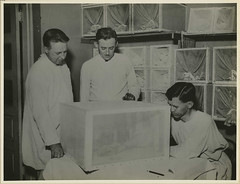
Emergency encephalitis laboratory. Jefferson Barracks, Missouri. (Major Cornell, Simmons and Sergeant Rhodes.) [The volunteer has put his arm in a screened cage to be bitten by mosquitoes. Scene. Laboratories. Military camps.]
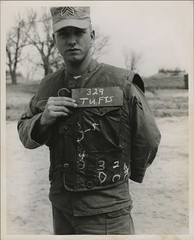
Armored Vest Number 329 worn by Private 1st Class Willie Tufts, US 52077771, with bullet holes circled and marked 1, 2, 3, 4, and 5. Company E, 7th Regiment. Front view. 04/26/1952. [Korean War]
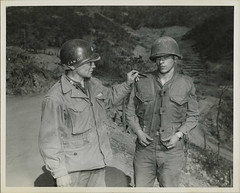
Captain Robert Bessey, Jr. (Cincinnati, OH), Infantry member of the Body Armor Team I, Company 15, Infantry Regiment, 30 Division, points to fragment hole in vest worn by Private Edward Schallack (4905 N. 36 St., Milwaukee, WI) who wore the vest on patrol. 04/24/1952. [Korean War]
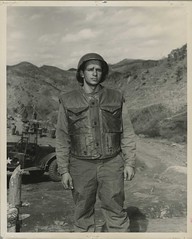
Private 1st Class Leo Curran, Jr., 46 1/2 Allen Street, Hudson, NY. E Company, 7th Regiment, 3rd Division. Was hit in back with fragment while wearing body armor vest on patrol. No penetration. 04/18/1952. [Korean War]
April 1st:
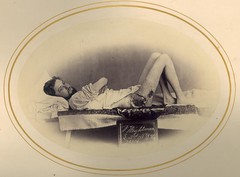
"Gunshot wound of hip." Private William W. Wrightman, Co. L, 2nd New York Heavy Artillery. Wounded at Petersburg, VA on March 31, 1865. Treated by Reed Bontecou at Harewood Hospital.[Civil War]
Friday, March 21, 2008
A Civil War plastic surgery article I helped on
Thursday, March 20, 2008
This week's flickr pictures
March 17th:
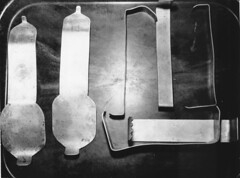
Retractors made from scrap metal. 44th Field Hospital, 8th Detachment. World War 2. 09/23/1945.
March 18:
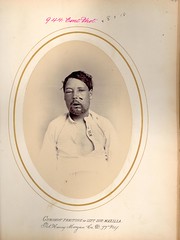
"Gunshot fracture of left superior maxilla." Private Henry Morgan, Co. D, 77th New York Volunteers, wounded at Petersburgh, VA on April 2, 1865. Treated at Harewood Hospital, Washington DC, by Dr. Reed B. Bontecou who also had the photograph made.
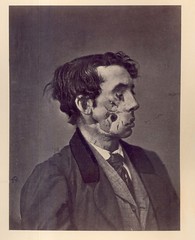
"Shell Wound of the face, with great destruction of the soft parts." Private Joseph Harvey, Co. C, 149th New York Volunteers. Wounded at Chancellorsville, Virginia on May 3 1863.
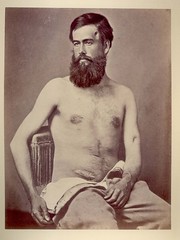
"Case of Corporal Bemis, Thrice Severely Wounded in Three Battles." Cpl. Edson D. Bemis, Co. K, 12th Massachussetts, wounded at Battles of Hatcher's Run, the Wilderness and Antietam.
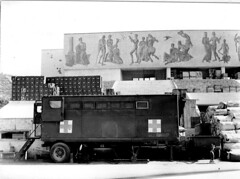
Mobile Optical Unit. 4th Medical Depot, Italy. 06/07/1944.
March 19:

Detachment of Hospital Corps taking patients over obstacles on the way to the hospital. Illustrating the equipment and operation of the brigade field hospital. Exhibit of the Army Medical Department, Pan-American Exposition, Buffalo, New York, 1901.

"Saboteuse" - World War II venereal disease prevention poster by editorial cartoonist C.D. Batchelor for the American Social Hygiene Association.
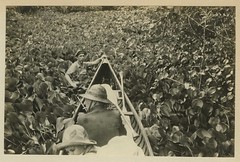
Panama. Dr. H.C. Clark. Gorgas Hospital. Ancon, Canal Zone. Club canoe forcing way through hyacinth beds, Pacora.
March 20:
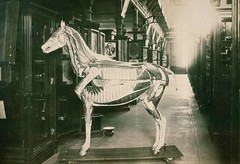
Comparative anatomy, Auzoux model of horse, life size. Specimen no. 2635. [papier mache, on display in Army Medical Museum] (We no longer have the model, although one can be seen in the Science Museum in London. This one's for Morbid Anatomy).
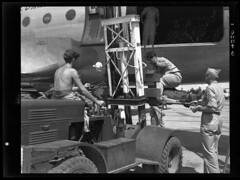
An enlisted technician rides along with patient to ground level to insure safety. from a series: "Air Evacuation from China to India," Patients flown over the 'hump' from China to India to be admitted to the 142nd General Hospital for further disposition.
More information about each picture can be seen on our flickr site. Visit our 3rd flickr page regularly, or sign up to be a contact so you know when new pictures go up.
Saturday, March 1, 2008
Our (possibly) most viewed Flickr image
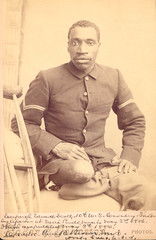
CP1855. The caption is: "Amputation of left thigh. [Image is reversed.] CPL Edward Scott, 10th U.S. Calvary. Injured May 3, 1886 at the Battle of Sierra Pinita, Mexico and treated by Dr. Paul R. Brown. Baker & Johnson Photos studio. "

